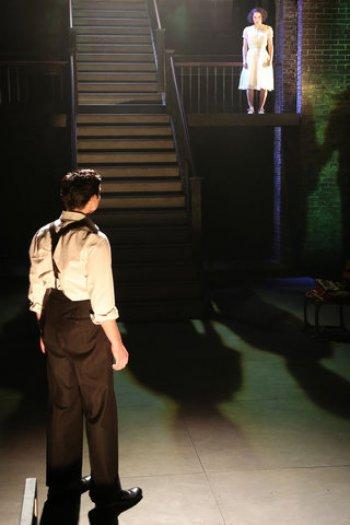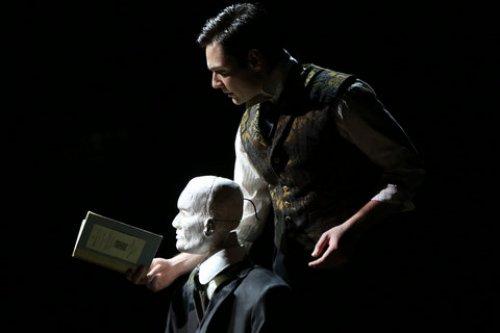He Brought Her Heart Back in a Box
Exquisite production of Adrienne Kennedy’s first play in nine years and most accessible: an investigation into racism in the Deep South, 1941 and its tragic aftermath.

Juliana Canfield and Tom Pecinka in a scene from Theatre for a New Audience’s production of Adrienne Kennedy’s “He Brought Her Heart Back in a Box” (Photo credit: Gerry Goodstein)
[avatar user=”Victor Gluck” size=”96″ align=”left” ] Victor Gluck, Editor-in-Chief[/avatar]Director Evan Yionoulis has given Adrienne Kennedy’s first play in nine years, He Brought Her Heart Back in a Box, an exquisite production at Theatre for a New Audience. Kennedy’s most accessible play, it tells a charged story of the Deep South in 1941 and its tragic aftermath, based on her personal experiences and family history. Exploring the topics of American race relations, bigotry, the Jim Crow South, and the rise of Nazism in Germany, He Brought Her Heart Back in a Box has a hypnotic quality like one of Tennessee Williams’ dream plays but with a firmer grounding in reality. The production reunites Kennedy and Yionoulis who directed the acclaimed revival of Kennedy’s Ohio State Murders for TFANA in 2007.
Whereas Kennedy became famous with plays that use myth, history, surrealism and Theater of the Absurd to tell their stories, this play tells a realistic tale in poetic form, its very brevity belying its depth of feeling. The play incorporates the styles of romantic drama, Elizabethan tragedy, old-fashioned operetta, a murder mystery, and recent history of the not so distant past. Events in the play were suggested by Kennedy’s mother and her own visits to her grandparents in the Jim Crow South.
Kay, a light-skinned young lady of mixed race, and Chris, the white son of Harrison Aherne, the wealthiest and most powerful man in Montefiore, have grown up in Georgia, on opposites of town, knowing of each other all their lives but separated by the color barrier. It is world where racism is both institutionalized and legal. Although Harrison has fathered three mixed race children who attend the “Boarding School for Colored” outside of town along with Kay, he has also been the architect of the town’s segregation policies. Kay’s 15-year-old mother died in Cincinnati when Kay was five days old, of either a self-inflicted wound or a murder, it is not known which.

Tom Pecinka and Juliana Canfield in a scene from Theatre for a New Audience’s production of Adrienne Kennedy’s “He Brought Her Heart Back in a Box” (Photo credit: Gerry Goodstein)
Chris works on the school accounts in the storeroom for his father, a member of the country board, a room whose iconic objects we see in video projections (photos, maps, drawings, books, “White/Colored” signs). He approaches Kay by ascending a long staircase as she listens in the wings to the school play, Marlowe’s The Massacre at Paris, an Elizabethan tragedy about a mixed marriage, one between a Catholic and a Protestant, and Harrison’s favorite play. The school year is ending for Kay who is off to Atlanta University and Chris who wants to be an actor and a singer plans to leave for New York City. They talk of their families, Chris’ mother having just died, and Kay having never been told the truth of her mother’s death, only the rumor that her father had returned from Cincinnati with her mother’s heart in a box.
Chris asks if he can write to her and then proposes, offering that they will in New York and then Paris after the war. Kay accepts. Six months later, the next events are told in letters, Chris writing from New York, and Kay from college, and later from the Jim Crow car, a shabby, segregated coach for African Americans, taking her North. He is obsessed with a trip he took as a child with his father to Berlin where the Germans he met admired the efficiency segregation of the American South, and his father’s constant attention to “the colored cemetery,” Aherne Gardens, that he has founded. Kay writes of her grandmothers, both black and white, and her troubled family history, while Chris gets a job in a production of Noel Coward’s romantic operetta, Bitter Sweet. The violent ending takes place in New York once they are reunited.
Both the extraordinarily subtle performances of Juliana Canfield’s Kay and Tom Pecinka’s Chris resemble the fragile, vulnerable, sensitive heroes and heroines of Williams’ Southern plays. They are particularly fine at giving everything they say a poetic feeling. The play also contains a silent seated third character, Chris’ father Harrison played by a life-sized mannequin and voiced by Pecinka, a brilliant device as his presence hovers over the entire play. Pecinka also demonstrates a lovely tenor as he sings Coward’s plaintive reverie, “Dear Little Café,” as well as declaiming the lines from the Marlowe tragedy for his father.

Tom Pecinka as Chris with life-sized mannequin of his father Harrison Aherne in a scene from Theatre for a New Audience’s production of Adrienne Kennedy’s “He Brought Her Heart Back in a Box” (Photo credit: Gerry Goodstein)
Christopher Barreca’s setting is a physical reminder of the world they live in. The thrust stage has six chairs that first represent the store room where Chris works and later the train taking Kay to New York. In the rear of the stage is a two story staircase with a landing halfway up, which ends in a far-off doorway. The stairway divides the stage in half, at the same time depicting the distance that Kay and Chris have to travel to meet up with each other. Austin Switser’s video design makes this poetic play more realistic with its depiction of solid object and people which floats over the stage. Montana Levi Blanco has designed elegant clothing changes for Kay, suggesting that her unseen father is paying for her education and lifestyle. Chris’ bland formal 1941 outfit gives way to his suit for his 1875 role in the Noel Coward operetta which immediately set the tone for this sequence. Donald Holder’s moody lighting which occasional throws long shadows and silhouettes puts everything in half-light as though being perceived through memory or a dream. Justin Ellington’s melancholy music also beautifully captures the mood of the play.
As acted by Tom Pecinka and newcomer Juliana Canfield making her New York stage debut, Adrienne Kennedy’s He Brought Her Heart Back in a Box sums up all of American racism in the 20th century while also telling a new love story in the short space of 45 minutes. Directed by Evan Yionoulis, the low-key acting makes the events and back story of the play that much more shocking. While Kennedy’s plays in the past (An Owl Answers, A Rat’s Mass, A Lesson in Dead Language, and Funnyhouse of a Negro) have tended to be obscure and difficult with personal mythology and a mash-up of historical characters, the new play is clarity itself. It does help to listen closely to the clues that are revealed and to realize the foreshadowing of both The Massacre at Paris and Bitter Sweet as love stories that do not end well.
He Brought Her Heart Back in a Box (through February 11, 2018)
Theatre for a New Audience
Samuel H. Scripps Mainstage, Polonsky Shakespeare Center, 262 Ashland Place, in Brooklyn
For tickets, call 866-811-4111 or visit http://www.tfana.org
Running time: 45 minutes without an intermission






Leave a comment